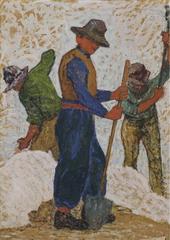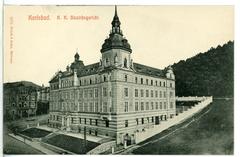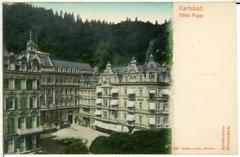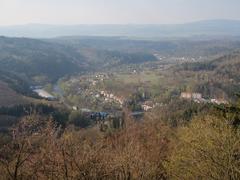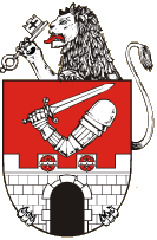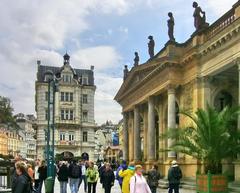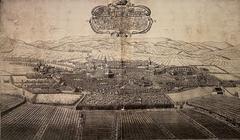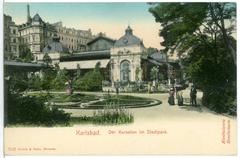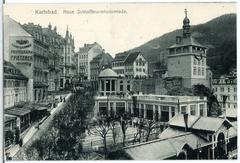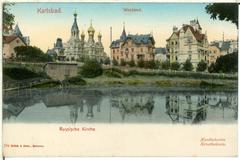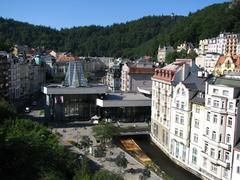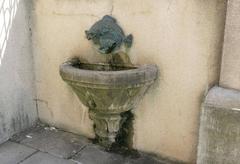
Chapel of the Virgin Mary Karlovy Vary: Visiting Hours, Tickets, and Historical Significance
Date: 04/07/2025
Introduction
Perched on a tranquil hillside above the famed Czech spa town of Karlovy Vary, the Chapel of the Virgin Mary stands as a symbol of the region’s enduring religious devotion and rich architectural heritage. Since its founding in the early 18th century, this chapel has witnessed transformations reflective of Central Europe’s cultural and spiritual evolution. From Baroque beginnings to Pseudo-Gothic revival, periods of neglect, and eventual restoration, the chapel’s story mirrors the broader narrative of Karlovy Vary itself.
This comprehensive guide details the chapel’s origins, architectural features, and cultural significance, while also providing essential visitor information—including hours, accessibility, and travel tips—to help you make the most of your visit. For official updates and further reading, see the Karlovy Vary tourism website and additional resources (Karlovy Vary history).
Contents
- Early Origins and Founding (1700)
- 18th and 19th Century Popularity
- Pseudo-Gothic Reconstruction (1885–1886)
- 20th Century Decline and Restoration
- Architectural and Artistic Features
- Visiting the Chapel: Practical Information
- Visiting Hours and Admission
- Accessibility
- Getting There
- Nearby Attractions
- Photography and Events
- Frequently Asked Questions (FAQ)
- Conclusion
- Sources
Early Origins and Founding (1700)
The Chapel of the Virgin Mary was commissioned in 1700 by Count Sternberg and his wife during their time in Karlovy Vary. Built in the then-popular Baroque style, the chapel was dedicated to the Virgin Mary of Sorrows, reflecting the deep Marian devotion of the period. Its prominent hillside location, behind the present-day Grandhotel Pupp, offered both a spiritual retreat and scenic views of the growing spa town (Karlovy Vary official site).
The early 18th century marked a period of transformation for Karlovy Vary, as its healing springs attracted European nobility and aristocracy. The construction of the chapel coincided with the town’s rise as a fashionable destination, further enriching its spiritual and cultural landscape (Karlovy Vary history).
18th and 19th Century Popularity
From its earliest days, the chapel was cherished by both locals and spa visitors as a place of reflection and prayer. Its reputation grew in 1808 with the visit of Johann Wolfgang von Goethe, who famously sketched the chapel and contributed to its fame among European travelers. Although ideas for expansion were considered in the late 1700s, significant changes did not occur until the 19th century (Karlovy Vary official site).
Pseudo-Gothic Reconstruction (1885–1886)
Between 1885 and 1886, the chapel underwent a dramatic transformation in the Pseudo-Gothic style, a movement inspired by medieval Gothic architecture. This renovation introduced pointed arches, decorative tracery, and a romantic silhouette, setting the chapel apart from other religious buildings in Karlovy Vary. The redesign, funded by the spa’s affluent patrons, included a two-flight staircase that heightened its dramatic presence on the hillside (Karlovy Vary official site).
20th Century Decline and Restoration
After World War II, the chapel suffered from neglect as political changes led to a decline in religious activity and maintenance. By the late 20th century, it had fallen into disrepair. Following the Velvet Revolution, restoration efforts began in 1991, focusing on preserving its Pseudo-Gothic elements while stabilizing the structure and improving access. The restored chapel once again became a hidden gem within Karlovy Vary’s cultural landscape (Karlovy Vary official site).
Architectural and Artistic Features
The Chapel of the Virgin Mary showcases a harmonious blend of Baroque origins and Pseudo-Gothic revival, with its pointed arches, elaborate stonework, and a distinctive two-flight staircase. While the interior is not regularly open to the public, the exterior remains a favorite subject for photographers and artists, much like in Goethe’s day. The wooded hillside location provides a peaceful atmosphere and stunning views over the town (Wikimedia Commons).
Visiting the Chapel: Practical Information
Visiting Hours and Admission
- Exterior Access: The chapel’s exterior and surrounding grounds are open to visitors year-round during daylight hours.
- Interior Access: The interior is not regularly open, except during special religious events or heritage days.
- Admission: There is no entrance fee.
Accessibility
- The chapel is accessed via a staircase and forest paths, which may be challenging for those with mobility limitations. Visitors are advised to wear suitable footwear and plan accordingly.
Getting There
- Walking Route: A scenic 600-meter walk from the Hot Spring along Mariánská Street, past the Diana Observation Tower funicular, leads up to the chapel.
- Funicular Option: Take the funicular to the Diana Tower and descend the blue-marked forest path to reach the chapel.
Nearby Attractions
- Grandhotel Pupp: A historic spa hotel near the chapel’s original site.
- Diana Observation Tower: Offers panoramic views of Karlovy Vary.
- Hot Spring Colonnade: Central to the spa town’s appeal.
Photography and Events
- The chapel’s picturesque exterior is ideal for photography. Special events, such as heritage walks or Marian feasts, may occasionally include the chapel—check the Karlovy Vary official site for updates.
Frequently Asked Questions (FAQ)
Q: What are the Chapel of the Virgin Mary’s visiting hours?
A: The chapel is accessible for exterior viewing during daylight hours; the interior is only open during special occasions.
Q: Is there an entrance fee?
A: No, visiting the chapel’s exterior is free.
Q: How do I get there from town?
A: Walk from the Hot Spring via Mariánská Street or take the funicular to Diana Tower and descend the forest path.
Q: Is the chapel accessible for visitors with limited mobility?
A: The hillside location and stairs may be challenging for some visitors.
Q: Are guided tours available?
A: Regular guided tours are not offered, but the chapel may be included in special heritage walks.
Conclusion
The Chapel of the Virgin Mary in Karlovy Vary is a remarkable testament to the town’s spiritual and architectural legacy. Its serene hillside setting, storied past, and striking Pseudo-Gothic features make it a rewarding destination for those seeking a deeper connection to Karlovy Vary’s cultural heritage. While interior access is limited, the chapel’s exterior and surroundings provide a peaceful retreat and a glimpse into the enduring traditions of this storied spa town.
Plan your visit with the Audiala app for offline maps, audio tours, and the latest event updates. For more, consult the official Karlovy Vary tourism page and related resources.
Sources and Further Reading
- Chapel of the Virgin Mary Karlovy Vary: History, Visiting Hours, and Visitor Guide, 2025 (Karlovy Vary official site)
- Karlovy Vary history, 2025 (Karlovy Vary history)
- Chapel of the Virgin Mary Karlovy Vary Wikimedia Commons, 2025 (Wikimedia Commons)


